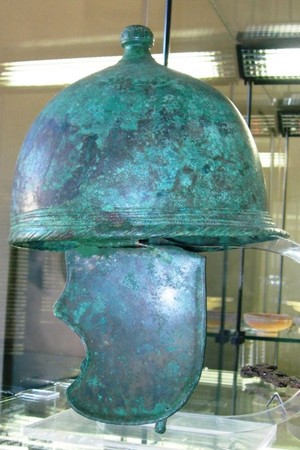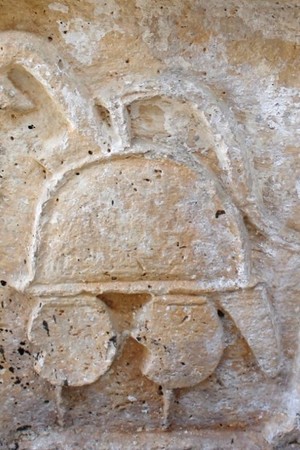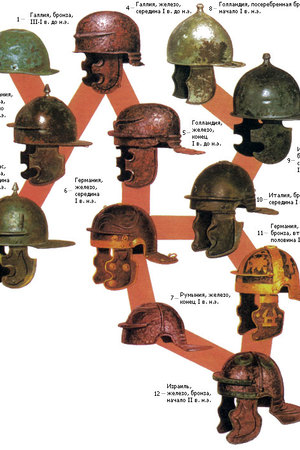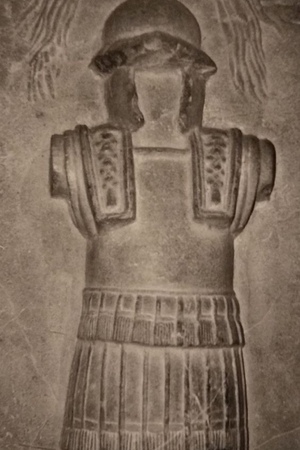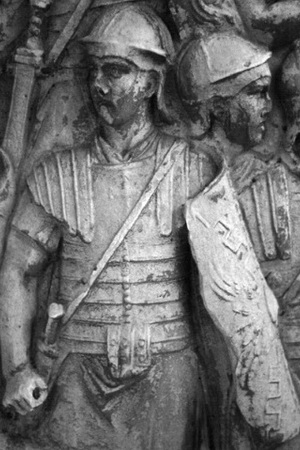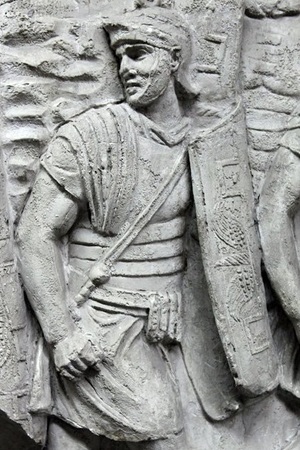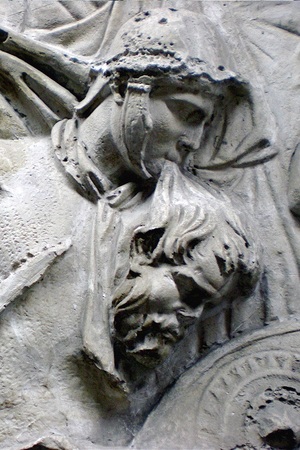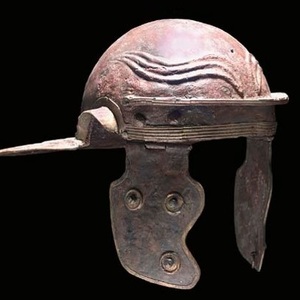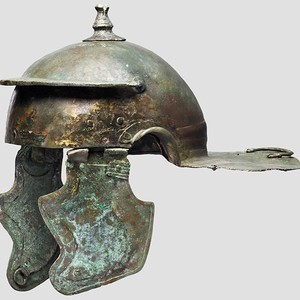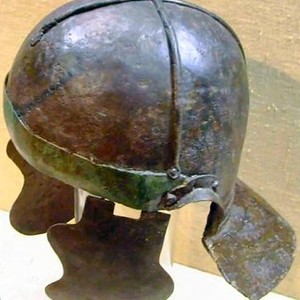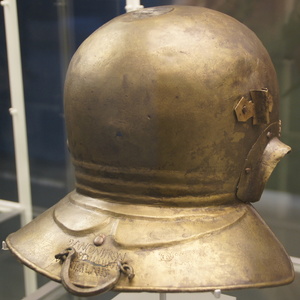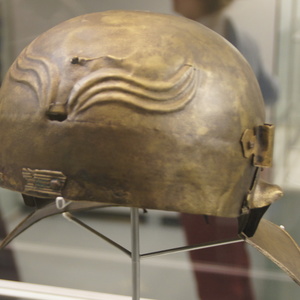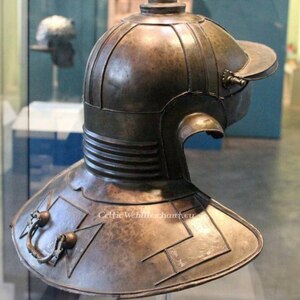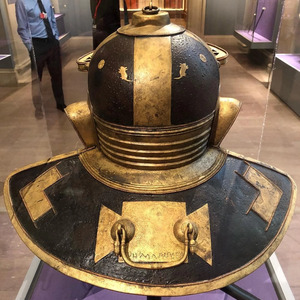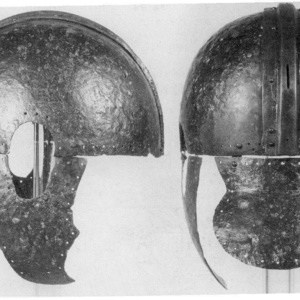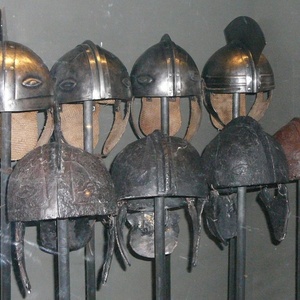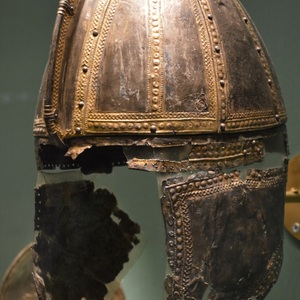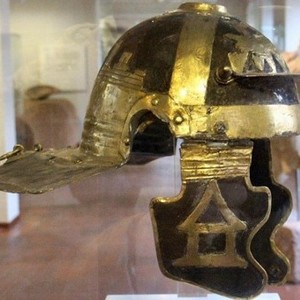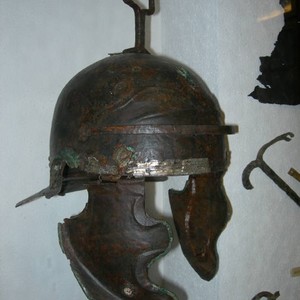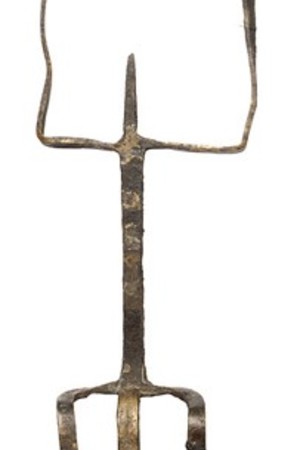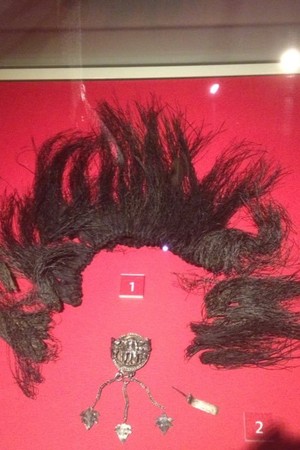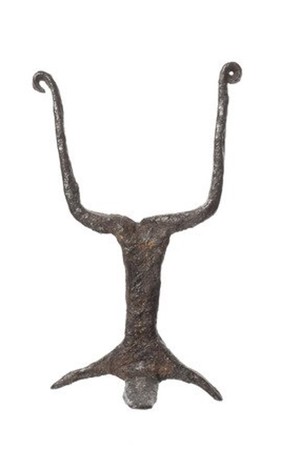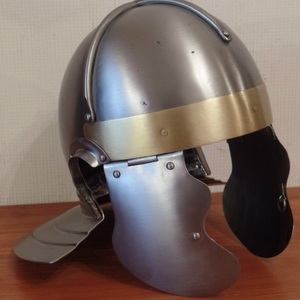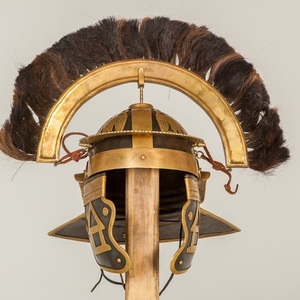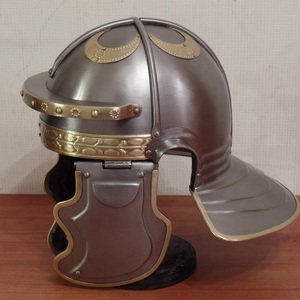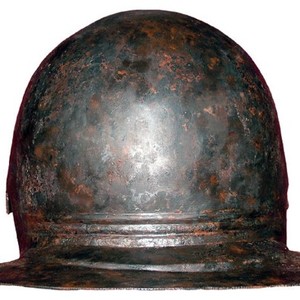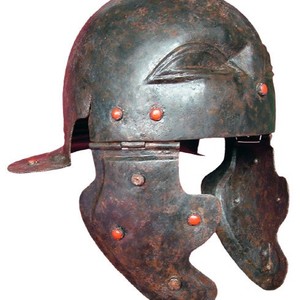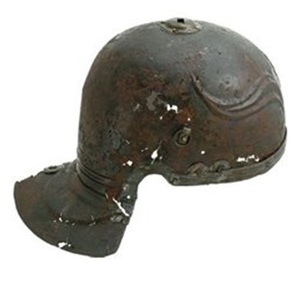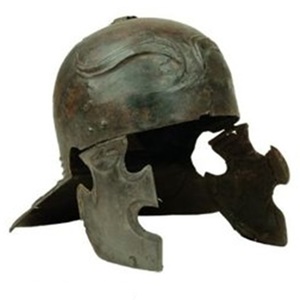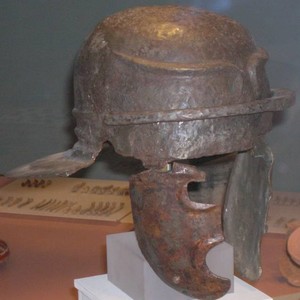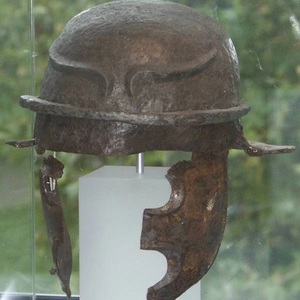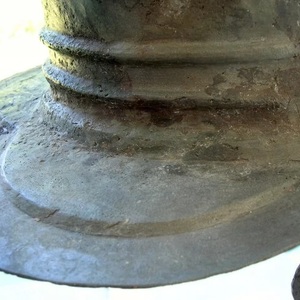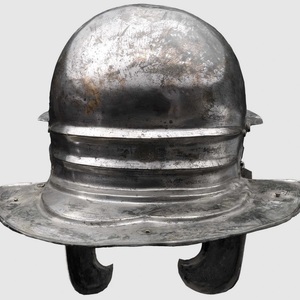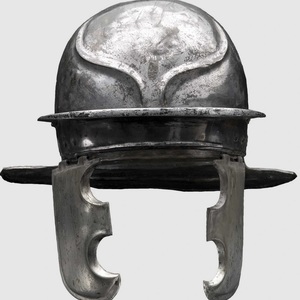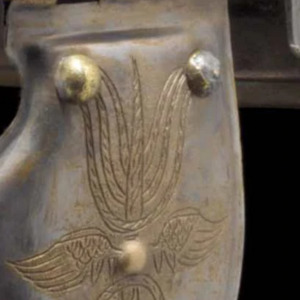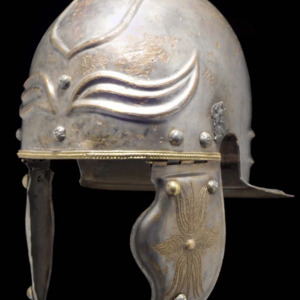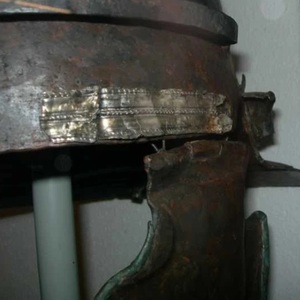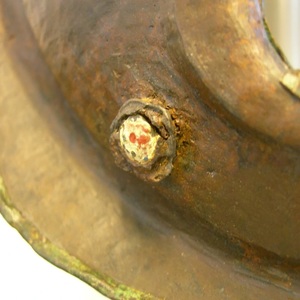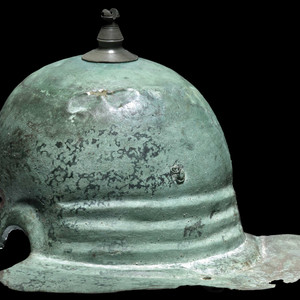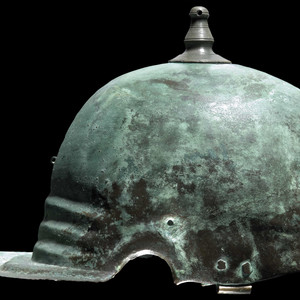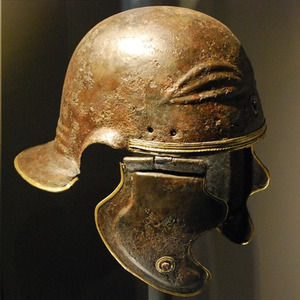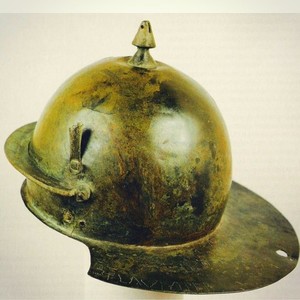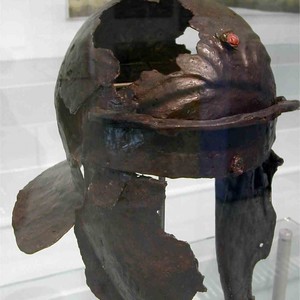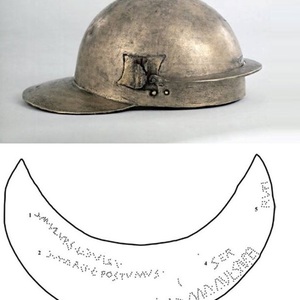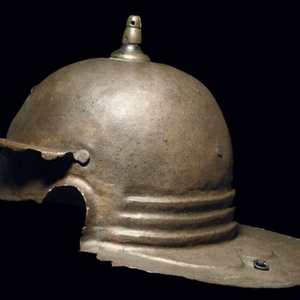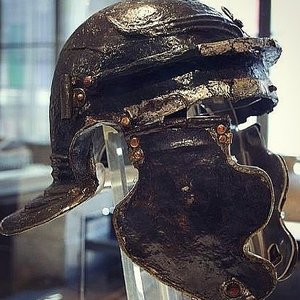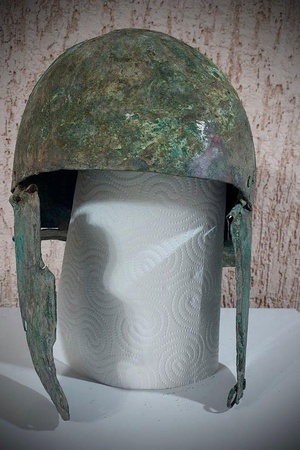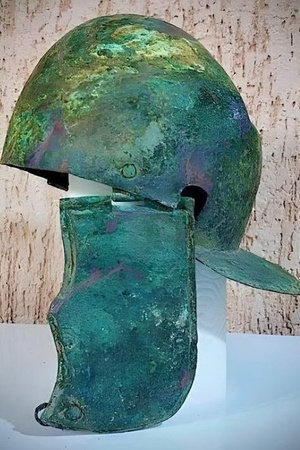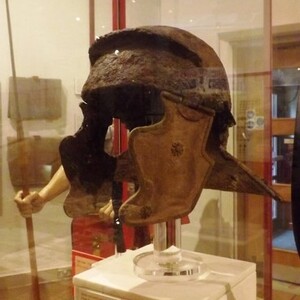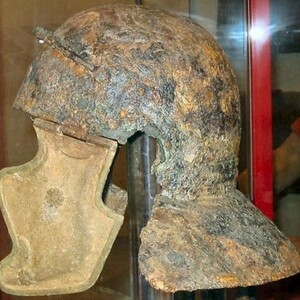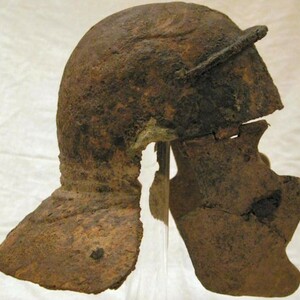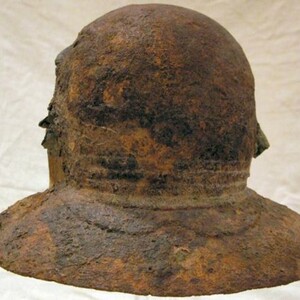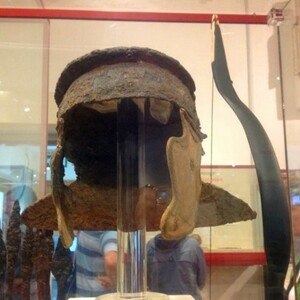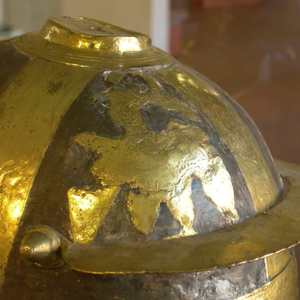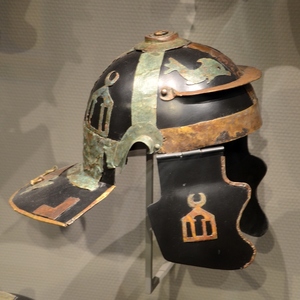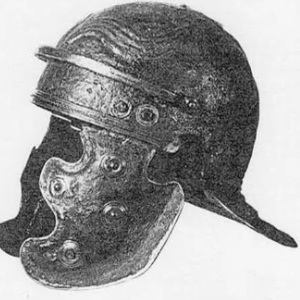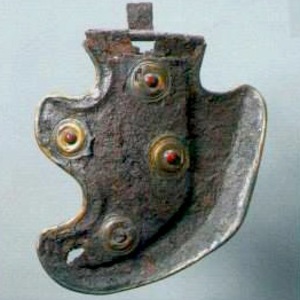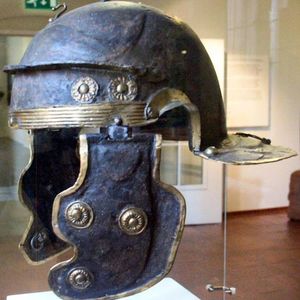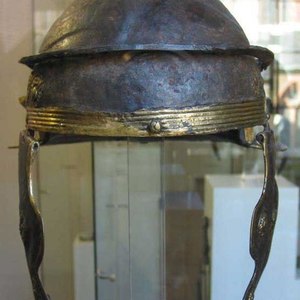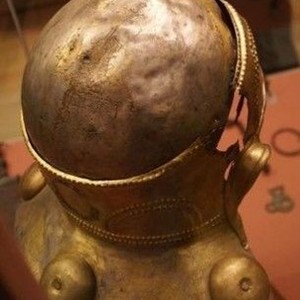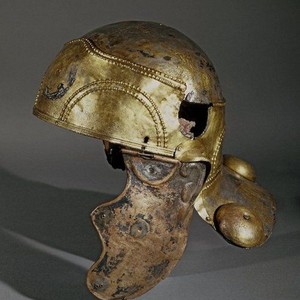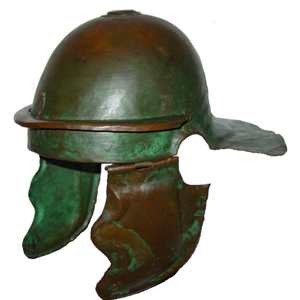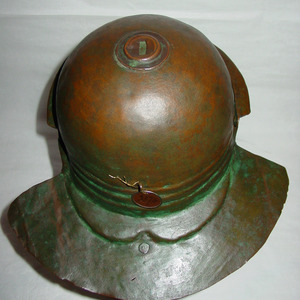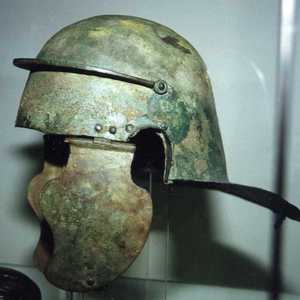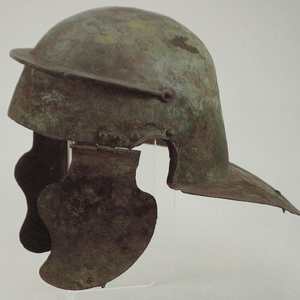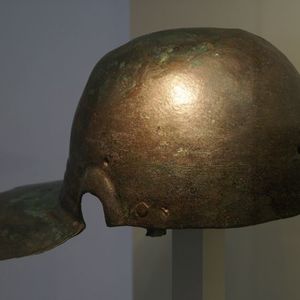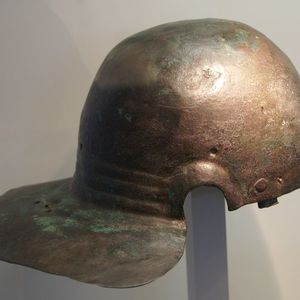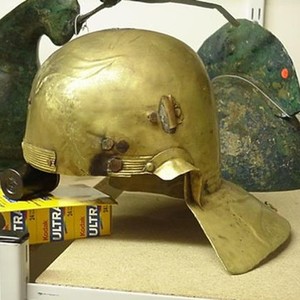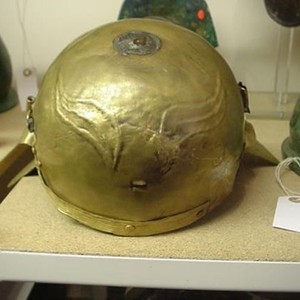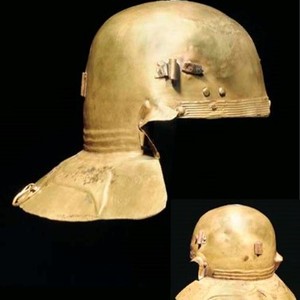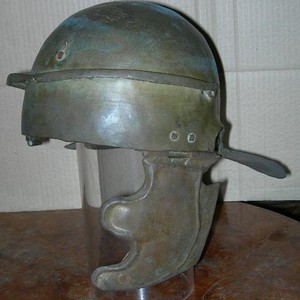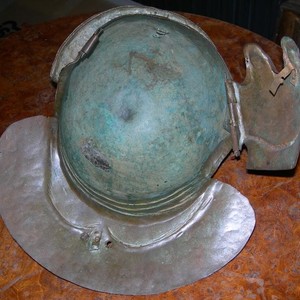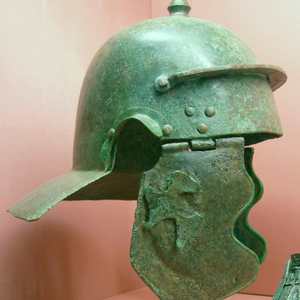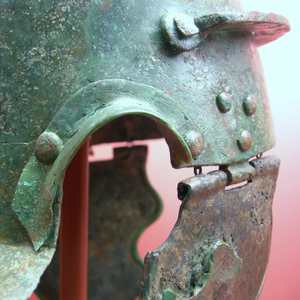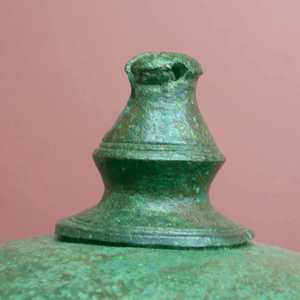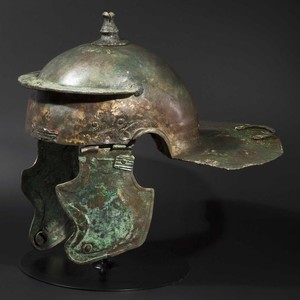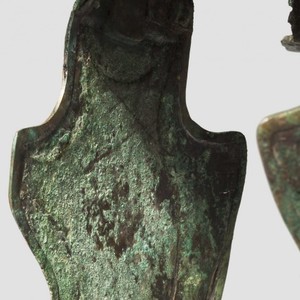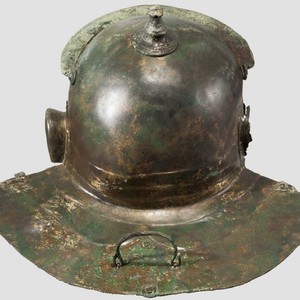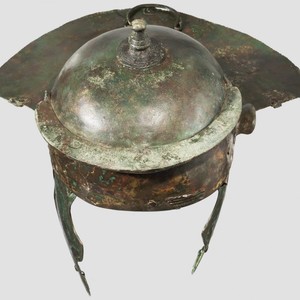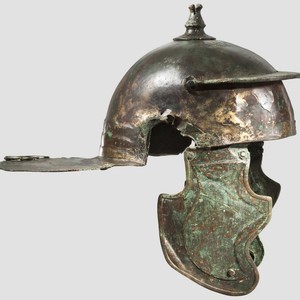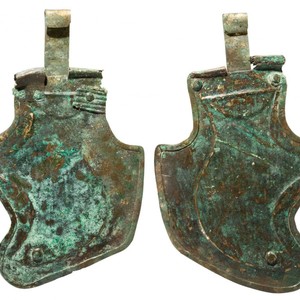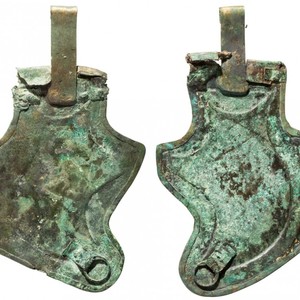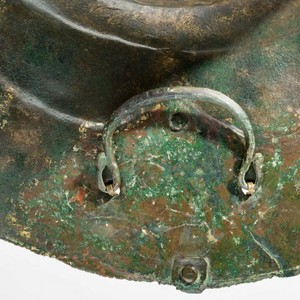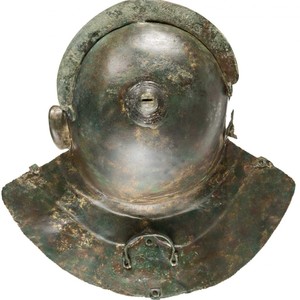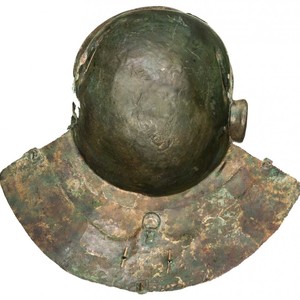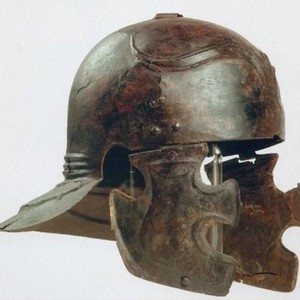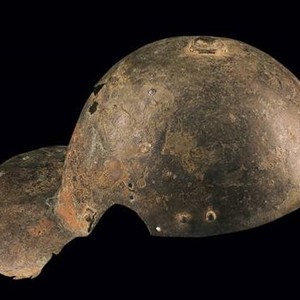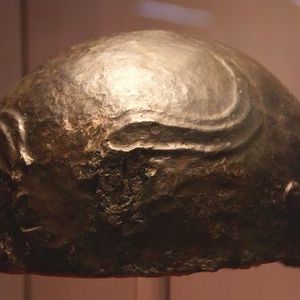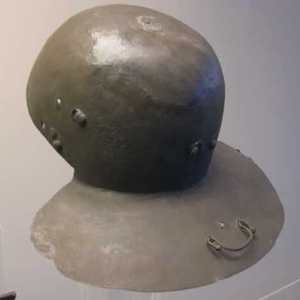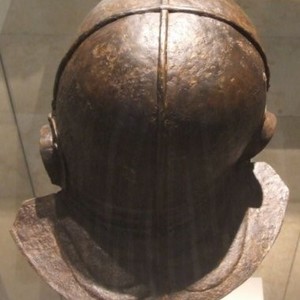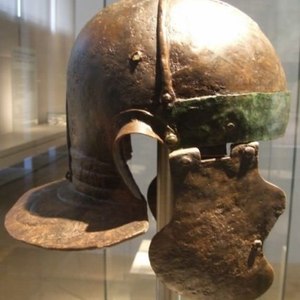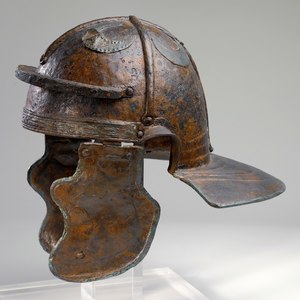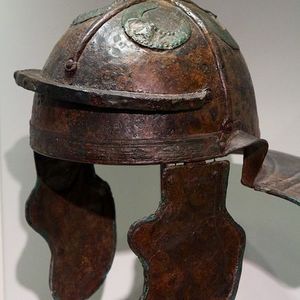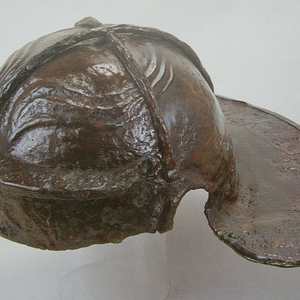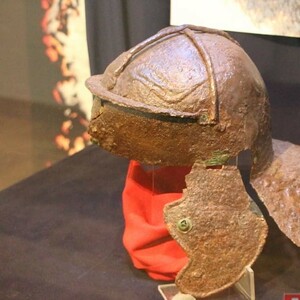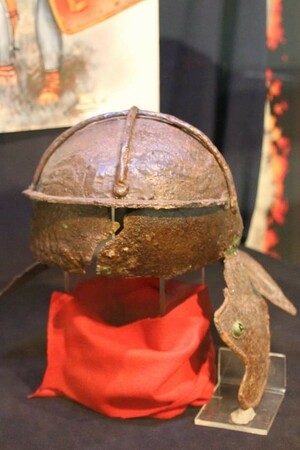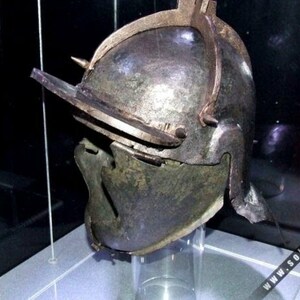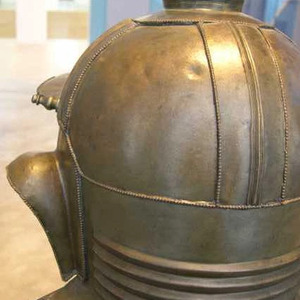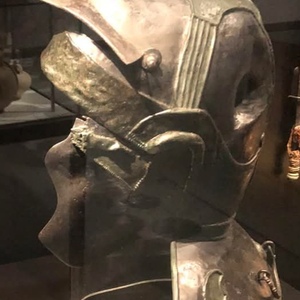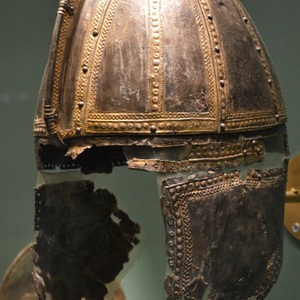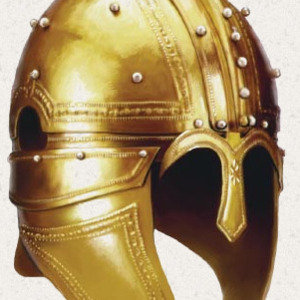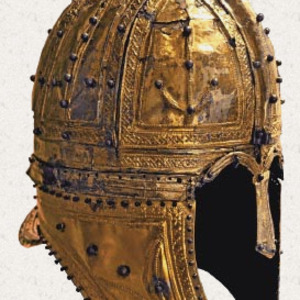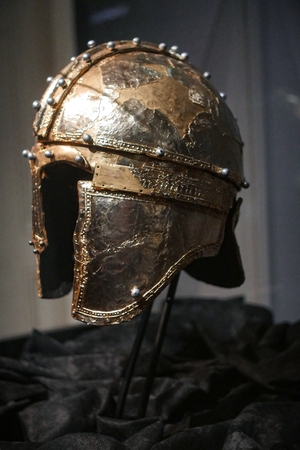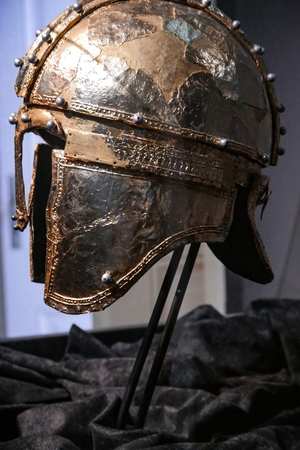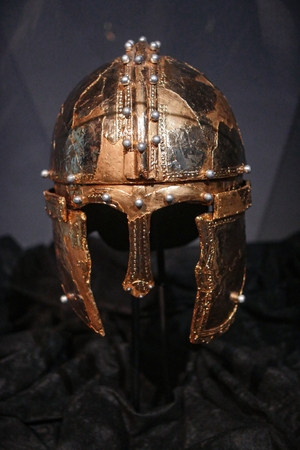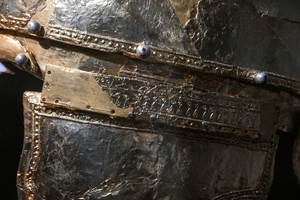Helmets of the Roman Army
Galea or Cassis (Latin: Galea / Cassis) - the ancient Roman term for a helmet. In the Roman army, the helmet was one of the main pieces of protective gear and was used by all combat units, such as legionaries, auxiliaries, and praetorians. It was typically worn with a sub-helmet made of felt, fabric, or leather.
Helmets in the Roman army did not provide full head protection - the face was always left exposed, which, given the tactics used, was not a significant issue. The exceptions were cavalrymen and standard-bearers, whose faces could be covered by a mask. The helmet was designed to protect the cheeks, crown, and back of the head, meaning the metal covered almost everything, leaving only the ears and face exposed. In a combat stance, the back of the helmet also protected part of the neck and upper back, leaving only a small vulnerable area.
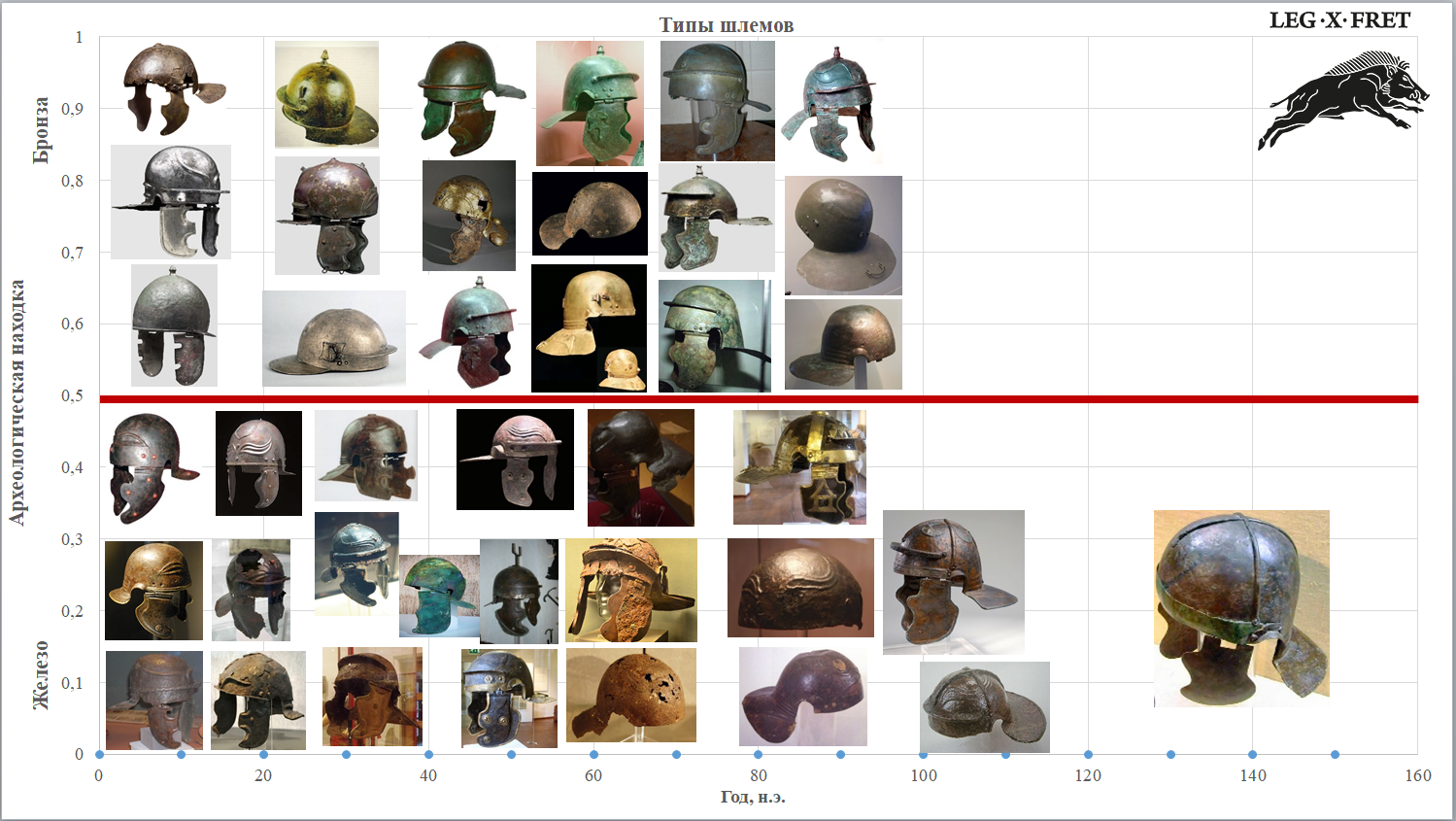
Prehistory
Helmets were used by almost all ancient civilizations. In Ancient Rome, the first models likely appeared under the influence of Celtic culture, where this type of protective gear was especially widespread. The first models of Roman helmets were almost completely copied from the Celts. This type of helmet was named "Montefortino," after the Celtic burial site Montefortino in northern Italy. The early models, unlike imperial helmets, did not have such large neck guards and had slightly different protective features. The most common material for making these helmets was bronze alloys. There are theories that helmets could be made not only by forging but also by casting, and a combined production method is also suggested (casting a blank first, then forging it to the final shape). At the top of the helmet, there was often a mount for a plume in the form of a small "knob" into which feathers or horsehair were inserted. The Montefortino helmet was used from the 4th century BC to the 50s AD.
Helmets in the Roman Army during the Principate Era
In the early Principate era, a new type of helmet, often referred to as the imperial type, replaced the Montefortino helmet. However, this transition was not instantaneous, and the Montefortino helmet continued to be used alongside the imperial type throughout the 1st century AD. The imperial helmet was used by Roman legionaries from the 1st to the 3rd centuries AD. These helmets are often named after their places of discovery; for instance, in Germany, they are known as Weisenau helmets. The ancient historian Connolly divides the imperial type helmet into two subtypes: the imperial Italic and the imperial Gallic. The primary distinction between them, and the basis for this classification, is that Gallic helmets feature embossed "eyebrow" waves on the forehead. This distinction is somewhat arbitrary, as the variety of finds makes classifying individual specimens challenging. Connolly also suggests that auxiliaries used helmets similar to those of the legionaries but simpler and cheaper to produce. It is also theorized that worn-out legionary equipment was handed down to the auxiliaries. Due to the stylization by artists, the preserved illustrative sources do not currently allow for distinguishing between legionary and auxiliary helmets.
Imperial helmets were made from bronze and iron alloys, with iron gradually replacing bronze over time. Bronze still dominated in the 1st century AD (as evidenced by the significantly greater number of bronze helmets found). However, by the 2nd century AD, the majority of archaeological finds are made of iron. Imperial helmets featured a solid dome with two cheek pieces, pivotally attached by hinges. They were often richly decorated with metal appliqués, embossing, enamel, and sometimes silver plating. The metal, especially iron, could be treated for corrosion resistance. The dome of the helmet was reinforced with crossbars for added strength against blows from above. Visors were used for additional face protection, and neck guards were used to protect the back of the head and neck.
It is also important to note the lifespan of the helmets. In the Roman army, there was a tradition of signing personal items to denote ownership and prevent theft. Helmets have been found signed by three different names. Even assuming not all owners survived their service, the helmets still had a considerable service life—approximately 50 years.
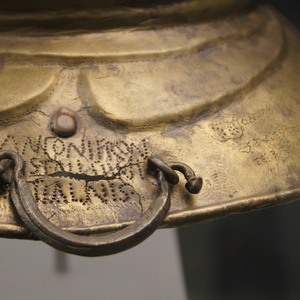 A Signed helmet. Imperial Gallic I type. Found in Rijswijk, on the Rhine, 15 km from the Batavian settlement of Til Passevaie. Mid to late 1st century CE
A Signed helmet. Imperial Gallic I type. Found in Rijswijk, on the Rhine, 15 km from the Batavian settlement of Til Passevaie. Mid to late 1st century CEHelmet in the Roman Army during the Era of the Soldier Emperors and the Dominate

At the end of the 2nd century AD, the Niederbieber type helmets became widespread in the Roman army, marking the pinnacle of the evolution of imperial helmets from the Principate era. According to archaeological finds, these helmets could be made entirely of bronze or steel, or of steel with bronze elements.
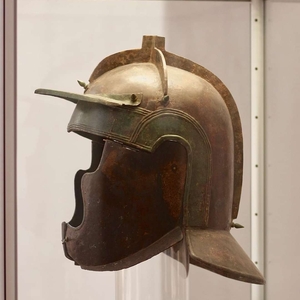 Helmet of the Niederbiber type, Heddernheim subtype, preserved in the Archaeological Museum of Frankfurt, turn of the 2nd-3rd centuries AD, side view
Helmet of the Niederbiber type, Heddernheim subtype, preserved in the Archaeological Museum of Frankfurt, turn of the 2nd-3rd centuries AD, side viewThese helmets remained in use until the last decades of the 3rd century AD, and according to some sources, until the first decade of the 4th century AD. However, from the second half of the 3rd century, Niederbieber type helmets began to be replaced by simpler ridge helmets. These helmets were assembled from two halves joined by a longitudinal ridge, clearly imitating Persian helmets, as wars with the Persians were ongoing throughout the 3rd and 4th centuries. These helmets are often grouped into two main categories: Intercisa, most commonly found in archaeology and iconography as helmets of regular soldiers, and Berkasovo, considered primarily cavalry and officer helmets. However, finds of both types of helmets often bear traces of gilded foil, embossing, and some specimens are richly decorated with gemstones and colored glass.
Crests and Officer Helmets
Officers likely used the same type of helmet as legionaries but with some modifications. Members of the standard-bearing group could wear the helmet with a mask and secure a predator's skin on top. Centurions attached a transverse crest (or plume) made of horsehair or feathers to their helmet. For this purpose, a "rosette" for the crest holder was located on the helmet's crown, with two rings on the sides to fix it in a transverse position. There is a theory, often seen among Western reenactors, that optio used longitudinal crests and a pair of feathers inserted on the sides. However, there is no archaeological evidence to support this. Only one imperial helmet has been found with inserts on the sides, but whether they were used for feathers and whether this was indeed an optio's helmet remains a big question.
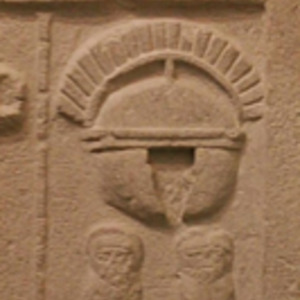 A fragment of a stele with a centurion from the 15th "Apollonian" Legion (Legio XV Apollinaris Pia Fidelis). Discovered in 1880 in the ruins of the Roman Carnuntum (Latin Carnuntum), reposited in Austria, Vienna Kunsthistorisches Museum. 1st century CE
A fragment of a stele with a centurion from the 15th "Apollonian" Legion (Legio XV Apollinaris Pia Fidelis). Discovered in 1880 in the ruins of the Roman Carnuntum (Latin Carnuntum), reposited in Austria, Vienna Kunsthistorisches Museum. 1st century CEEvidence of probable crest wearing on helmets includes one found crest with black horsehair, as well as numerous "forks" for attaching crests to helmets of various constructions and shapes. Crests were tied to the helmet with cords through rings near the ear holes if the helmet belonged to a centurion, or on the forehead and back of the head if the crest was attached longitudinally. For legates and praetorians the crest could also be attached longitudinally, and the plume could be inserted into a special slot resembling a "cassette."
Reenactment
Most helmets are suitable for both legionaries and auxiliaries. The main thing is to choose the correct reconstruction period. Since there is evidence that helmets could change owners multiple times, their usage period could exceed 50 years! This means that earlier helmets could be used at the beginning of the second century, but not vice versa - later helmets cannot be used for earlier periods. For reconstruction, there are two approaches to helmet production - authentic seamless and stylized welded. The latter is cheaper, and it is recommended to start with it by choosing the simplest and cheapest type - for example, Imperial Italic J1. Later, one can strive for more interesting and seamless options.
Related Topics
Legionnary, Auxiliary, Centurion, Vexillarius, Praetorian, Celts, Optio
Literature
- Connolly, Peter. Greece and Rome: Encyclopedia of Military History. — Moscow: EKSMO-Press, 2001. — ISBN 5-04-005183-2.
- Raffaele D'Amato, Andrey Negin. Decorated Roman Armour.

 Early to mid first century
Early to mid first century






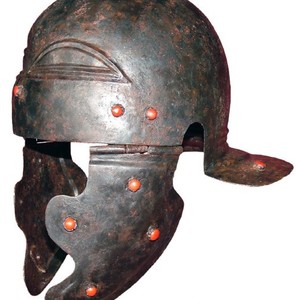 Imperial Gallic B helmet. Museum Carnuntinum, Austria, Bad Deutsch-Altenburg. Beguinning of 1st century CE
Imperial Gallic B helmet. Museum Carnuntinum, Austria, Bad Deutsch-Altenburg. Beguinning of 1st century CE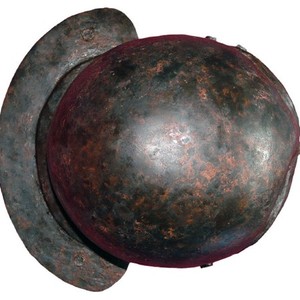 Imperial Gallic B helmet. Museum Carnuntinum, Austria, Bad Deutsch-Altenburg. Beguinning of 1st century CE
Imperial Gallic B helmet. Museum Carnuntinum, Austria, Bad Deutsch-Altenburg. Beguinning of 1st century CE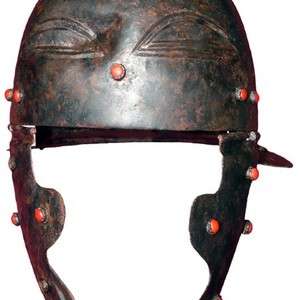 Imperial Gallic B helmet. Museum Carnuntinum, Austria, Bad Deutsch-Altenburg. Beguinning of 1st century CE
Imperial Gallic B helmet. Museum Carnuntinum, Austria, Bad Deutsch-Altenburg. Beguinning of 1st century CE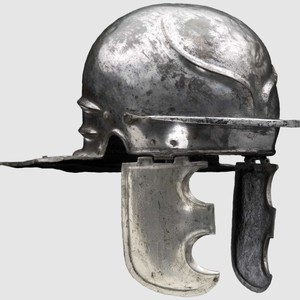 Imperial Gallic A helmet. Tinned bronze. Private collection of Axel Guttmann. Beguinning of the first century CE
Imperial Gallic A helmet. Tinned bronze. Private collection of Axel Guttmann. Beguinning of the first century CE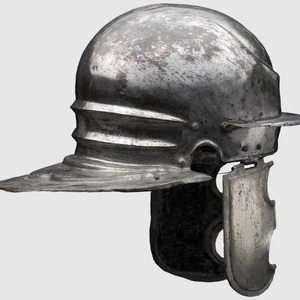 Imperial Gallic A helmet. Tinned bronze. Private collection of Axel Guttmann. Beguinning of the first century CE
Imperial Gallic A helmet. Tinned bronze. Private collection of Axel Guttmann. Beguinning of the first century CE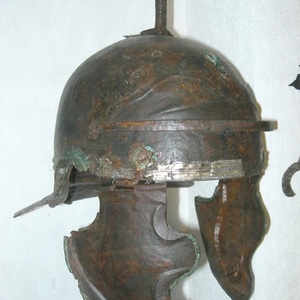 Imperial Gallic F helmet. The main material is iron. Found in Witcham Gravel, Ely, Cambridgeshire. Reposited in the Canterbure Roman Museum. Early to mid 1st century CE
Imperial Gallic F helmet. The main material is iron. Found in Witcham Gravel, Ely, Cambridgeshire. Reposited in the Canterbure Roman Museum. Early to mid 1st century CE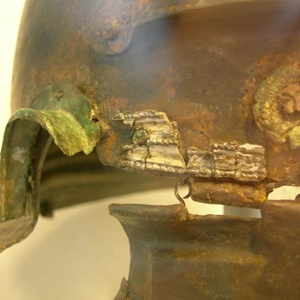 Imperial Gallic F helmet fragment. The main material is iron. Found in Witcham Gravel, Ely, Cambridgeshire. Reposited in the Canterbure Roman Museum. Early to mid 1st century CE
Imperial Gallic F helmet fragment. The main material is iron. Found in Witcham Gravel, Ely, Cambridgeshire. Reposited in the Canterbure Roman Museum. Early to mid 1st century CE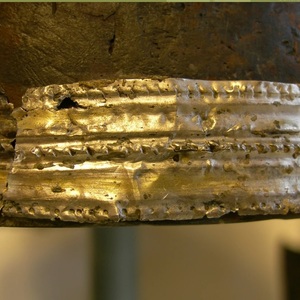 Imperial Gallic F helmet fragment. The main material is iron. Found in Witcham Gravel, Ely, Cambridgeshire. Reposited in the Canterbure Roman Museum. Early to mid 1st century CE
Imperial Gallic F helmet fragment. The main material is iron. Found in Witcham Gravel, Ely, Cambridgeshire. Reposited in the Canterbure Roman Museum. Early to mid 1st century CE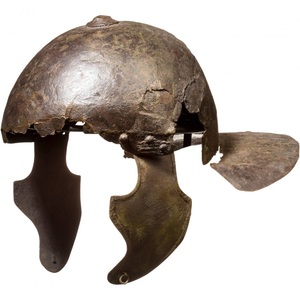 Imperial Italic helmet Weisenau. Bronze. The height of the helmet with a stand is 400 mm, the depth is 360 mm, the dome width is 200 mm, the neck guard width is 260 mm. Cheek plates are a modern reenactment. Sold at the Hermann Historica auction. May auction # A79aw, lot # 1051. Early to mid 1st century CE
Imperial Italic helmet Weisenau. Bronze. The height of the helmet with a stand is 400 mm, the depth is 360 mm, the dome width is 200 mm, the neck guard width is 260 mm. Cheek plates are a modern reenactment. Sold at the Hermann Historica auction. May auction # A79aw, lot # 1051. Early to mid 1st century CE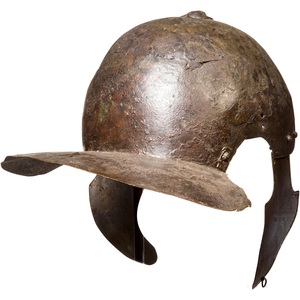 Imperial Italic helmet Weisenau. Bronze. The height of the helmet with a stand is 400 mm, the depth is 360 mm, the dome width is 200 mm, the neck guard width is 260 mm. Cheek plates are a modern reenactment. Sold at the Hermann Historica auction. May auction # A79aw, lot # 1051. Early to mid 1st century CE
Imperial Italic helmet Weisenau. Bronze. The height of the helmet with a stand is 400 mm, the depth is 360 mm, the dome width is 200 mm, the neck guard width is 260 mm. Cheek plates are a modern reenactment. Sold at the Hermann Historica auction. May auction # A79aw, lot # 1051. Early to mid 1st century CE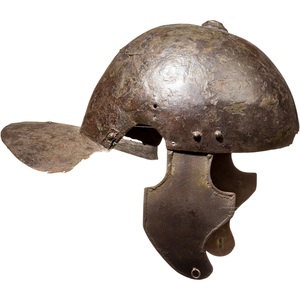 Imperial Italic helmet Weisenau. Bronze. The height of the helmet with a stand is 400 mm, the depth is 360 mm, the dome width is 200 mm, the neck guard width is 260 mm. Cheek plates are a modern reenactment. Sold at the Hermann Historica auction. May auction # A79aw, lot # 1051. Early to mid 1st century CE
Imperial Italic helmet Weisenau. Bronze. The height of the helmet with a stand is 400 mm, the depth is 360 mm, the dome width is 200 mm, the neck guard width is 260 mm. Cheek plates are a modern reenactment. Sold at the Hermann Historica auction. May auction # A79aw, lot # 1051. Early to mid 1st century CE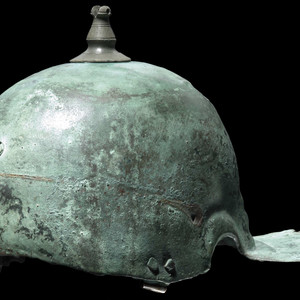 Vaisau helmet type, Imperial Italic. The height of the helmet is 19.5 cm, it weights 1400 g., made out bronze. Courtesy Hermann Historica, International auction-Munich-D. Early to mid 1st century CE
Vaisau helmet type, Imperial Italic. The height of the helmet is 19.5 cm, it weights 1400 g., made out bronze. Courtesy Hermann Historica, International auction-Munich-D. Early to mid 1st century CE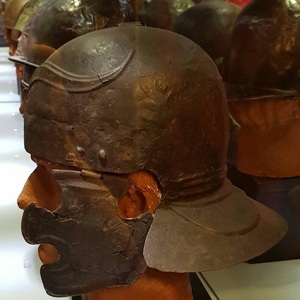 Weisenau Imperial gallic C helmet. Found in Siscia. Arheological museum in Zagreb, Croatia. Early to mid 1st century CE
Weisenau Imperial gallic C helmet. Found in Siscia. Arheological museum in Zagreb, Croatia. Early to mid 1st century CE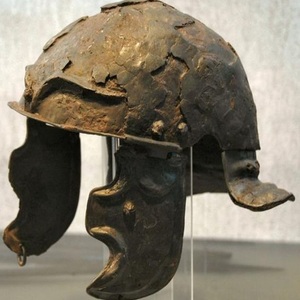 An Agent-Port helmet. Found in Rouen, France. Reposited in the Aalen Museum, Germany. First half of the 1st century AD
An Agent-Port helmet. Found in Rouen, France. Reposited in the Aalen Museum, Germany. First half of the 1st century AD

 Mid to late first century
Mid to late first century






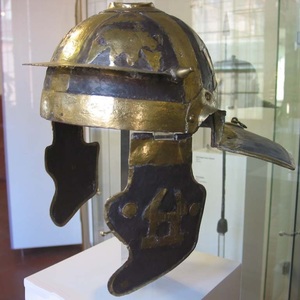 Imperial Italic D helmet. There is a "socket" for the crest. Iron with bronze decorations. Found at the bottom of the Rhine, Mainz (Germany). City Museum of Worms. 4th quarter of the 1st century CE
Imperial Italic D helmet. There is a "socket" for the crest. Iron with bronze decorations. Found at the bottom of the Rhine, Mainz (Germany). City Museum of Worms. 4th quarter of the 1st century CE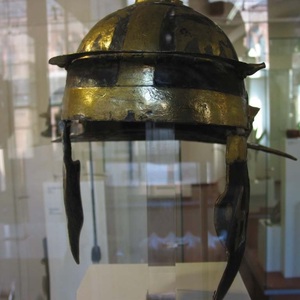 Imperial Italic D helmet. There is a "socket" for the crest. Iron with bronze decorations. Found at the bottom of the Rhine, Mainz (Germany). City Museum of Worms. 4th quarter of the 1st century CE
Imperial Italic D helmet. There is a "socket" for the crest. Iron with bronze decorations. Found at the bottom of the Rhine, Mainz (Germany). City Museum of Worms. 4th quarter of the 1st century CE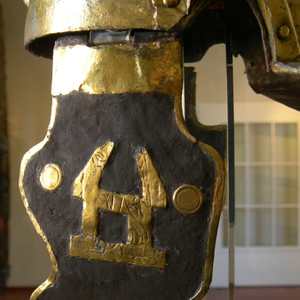 Imperial Italic D helmet. There is a "socket" for the crest. Iron with bronze decorations. Found at the bottom of the Rhine, Mainz (Germany). City Museum of Worms. 4th quarter of the 1st century CE
Imperial Italic D helmet. There is a "socket" for the crest. Iron with bronze decorations. Found at the bottom of the Rhine, Mainz (Germany). City Museum of Worms. 4th quarter of the 1st century CE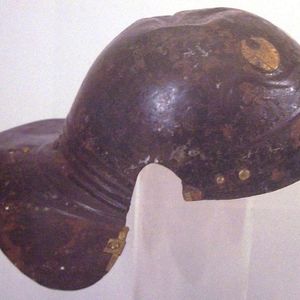 Imperial Gallic K helmet. Iron. Found in Wiesbaden (Germany). Municipal Museum - Wiesbaden-D. Mid to late 1st century CE
Imperial Gallic K helmet. Iron. Found in Wiesbaden (Germany). Municipal Museum - Wiesbaden-D. Mid to late 1st century CE

 Early to mid second century
Early to mid second century






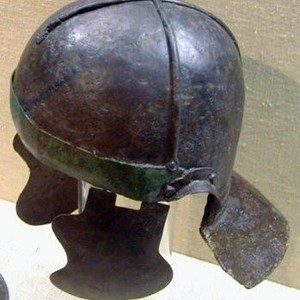 Imperial italic J1 helmet. Theilenhofen. Iron with bronze inserts. First quarter of the 2nd century CE
Imperial italic J1 helmet. Theilenhofen. Iron with bronze inserts. First quarter of the 2nd century CE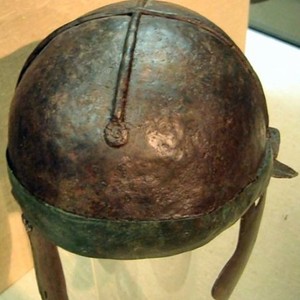 Imperial italic J1 helmet. Theilenhofen. Iron with bronze inserts. First quarter of the 2nd century CE
Imperial italic J1 helmet. Theilenhofen. Iron with bronze inserts. First quarter of the 2nd century CE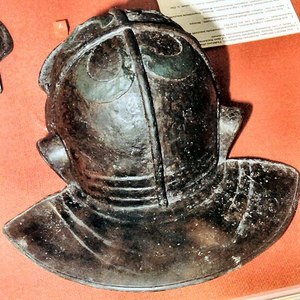 Imperial Italic G helmet. Found in a cave near Hebron (Palestinian Authority, Israel). It is believed that it belonged to the legionnary from Legio X Fretensis. Early to mid 2nd century CE
Imperial Italic G helmet. Found in a cave near Hebron (Palestinian Authority, Israel). It is believed that it belonged to the legionnary from Legio X Fretensis. Early to mid 2nd century CE

 Second half of the second and third century
Second half of the second and third century






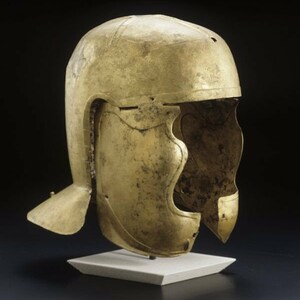 A helmet of the Niederbiber type from Rheinau-Buch, 3rd century AD, preserved in the Württemberg Landsmuseum
A helmet of the Niederbiber type from Rheinau-Buch, 3rd century AD, preserved in the Württemberg Landsmuseum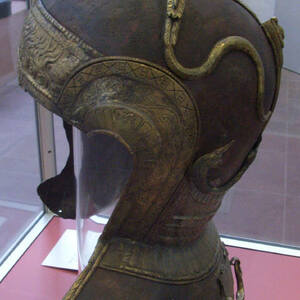 The Niederbiber helmet from Heddernheim, the turn of the 2nd-3rd centuries AD, is kept in the Frankfurt Archaeological Museum
The Niederbiber helmet from Heddernheim, the turn of the 2nd-3rd centuries AD, is kept in the Frankfurt Archaeological Museum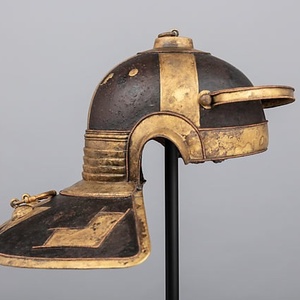 Helmet type Imperial Italic H, mid-3rd century AD, private collection. The owner's name is stamped inside — Julius Mansuetus
Helmet type Imperial Italic H, mid-3rd century AD, private collection. The owner's name is stamped inside — Julius Mansuetus

 Fourth century and later
Fourth century and later






